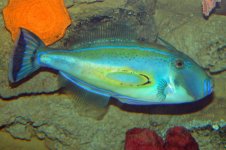Since this forum is new, I thought I might post some fish bios as I have the time....just to jump start things a bit.
Horseshoe leatherjacket, Meuschenia hippocrepis
Max. size: 50 cm TL
Environment: demersal; marine; depth range 1- 20 m
Climate: temperate
Distribution: Eastern Indian Ocean: Australia (southern Western Australia to Victoria and Tasmania).
Biology: Occurs on offshore reefs. The black horse-shoe marking along flanks is diagnostic for this species.
Habitat: Kelp forests, rocky reefs
Range: South Australia
An interesting filefish from Southern Australia, this species of filefish is heavy bodied, almost triggerfish-like. Juveniles do not seem too aggressive; in fact, they seem rather shy at first. As they grow and become accustomed to captivity, they become territorial and may begin to attack more peaceful fish in the aquarium. This aggressive tendency may be short-lived, with the leatherjacket returning to its prior peaceful nature after a day or so. Watch for this fish to develop a dark patch on its face that seems to correlate with an increase in aggression. This species does well if kept between 62 and 70 degrees, it is unknown what their upper temperature limit is.
Horseshoe leatherjacket, Meuschenia hippocrepis
Max. size: 50 cm TL
Environment: demersal; marine; depth range 1- 20 m
Climate: temperate
Distribution: Eastern Indian Ocean: Australia (southern Western Australia to Victoria and Tasmania).
Biology: Occurs on offshore reefs. The black horse-shoe marking along flanks is diagnostic for this species.
Habitat: Kelp forests, rocky reefs
Range: South Australia
An interesting filefish from Southern Australia, this species of filefish is heavy bodied, almost triggerfish-like. Juveniles do not seem too aggressive; in fact, they seem rather shy at first. As they grow and become accustomed to captivity, they become territorial and may begin to attack more peaceful fish in the aquarium. This aggressive tendency may be short-lived, with the leatherjacket returning to its prior peaceful nature after a day or so. Watch for this fish to develop a dark patch on its face that seems to correlate with an increase in aggression. This species does well if kept between 62 and 70 degrees, it is unknown what their upper temperature limit is.







